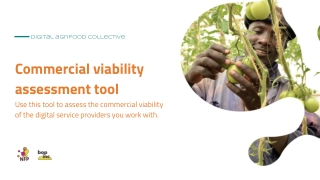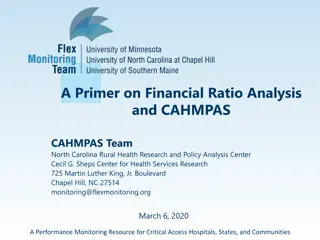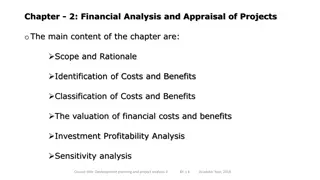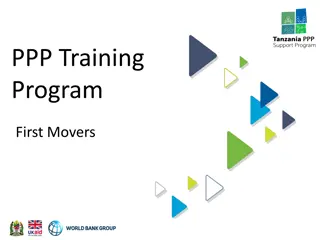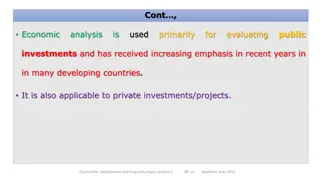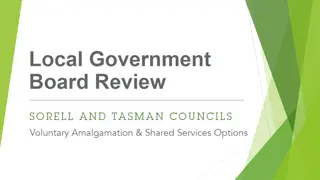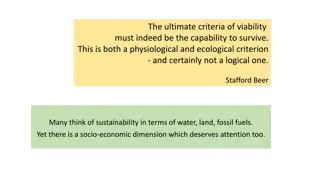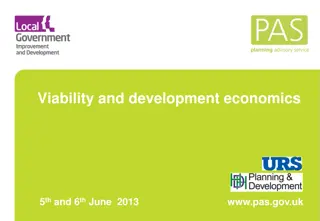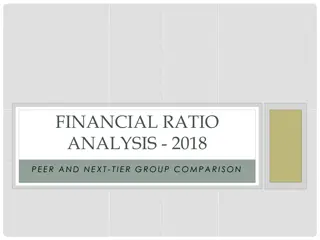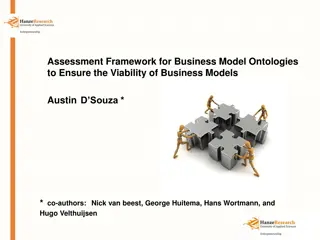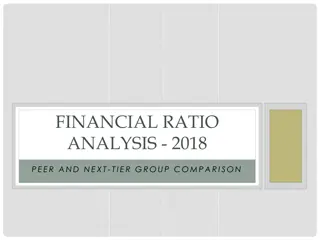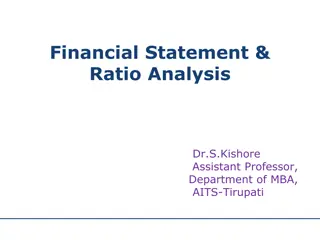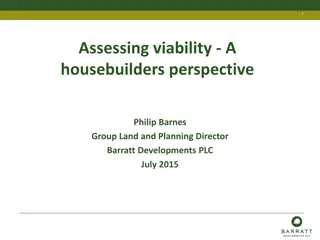Understanding Financial Viability in Project Analysis
Explore the importance of cash flow, profitability measures like NPV and FIRR, and different aspects of financial assessments in project analysis. The content covers assessing viability, return on capital, and cost recovery in various economic scenarios.
Download Presentation

Please find below an Image/Link to download the presentation.
The content on the website is provided AS IS for your information and personal use only. It may not be sold, licensed, or shared on other websites without obtaining consent from the author. Download presentation by click this link. If you encounter any issues during the download, it is possible that the publisher has removed the file from their server.
E N D
Presentation Transcript
The Financial Analysis had to Consider Both Criteria cash flow profits
3 Basic Assessment Project can earn an adequate rate of return based on market Weighted Average Cost of Capital. Financially Viable Viability Viability Assessment Assessment Project fails to earn a sufficient return. No opportunity for significant tariff Increases. Not Financially Viable
Basic Assessment Project cash flow is adequate. Positive Cash Flow Throughout Cash Flow Assessment Project cash flow negative in any given year. Problematic Cash Flow
Project FIRR and NPV Measures Profitability of the Project The NPV is the value of the sum of projected cash flows discounted at the cost of capital. Typically the assessment was done on the basis of total return. Any value over zero indicates adequate return, but the higher positive value show a higher return. The NPV calculation Does not give you re the exact rate of return. Just tells you that you are either above or below your threshold level. How We Measure Financial Viability The Financial Internal Rate of Return is the rate of return expressed as a percentage that the Project yields. Through extrapolation you can equate the two by either increasing or decreasing the discount rate so that the NPV equals zero. In other words if your NPV is 0 at 15% discount rate then the FIRR should be 15%. Projected Cashflows Measure Repayment Obligations Also conducted on the basis Project s total return
Total Return Versus Return on Capital Total Return to Investment (ROI) Refers to a Projects return on total investment. Calculated as the NPV or FIRR based on cash flows that disregard debt servicing. This provides determines the total return that the project earns irrespective of financing option. Return to Capital (ROE) Refers to the total return only to the capital contribution and cash flows specifically incorporate the cost of financing and debt service to external borrowers. What are Advantages and Disadvantages of Each?
Why the Change in FA for Water Projects? Survey of Cost Recovery of WSPs in Different Economies
Why the Change? How Meaningful is a Project FIRR in an Environment Where How Meaningful is a Project FIRR in an Environment Where Most WSPs Have Difficulty Recovering Even their O&M Most WSPs Have Difficulty Recovering Even their O&M Costs? Costs? How Meaningful is the Project s cash flow? How Meaningful is the Project s cash flow?
What Does it Take to Become Financially Sustainable?
If Money Could Truly Grow on Trees
Financial Sustainability Involves: Meeting Financial Obligations of the System Reliability and Cost of External Funding Sources
Basic Financial Sustainability Assessment Revised Project consolidated cash flow is adequate. Positive Cash Flow Throughout Cash Flow Assessment Project Consolidated cash flow negative in any given year. Problematic Cash Flow Consolidated refers to a single entity or an entire water system with multiple entities.
Obstacles to Financial Sustainability FINANCIAL SUSTAINABILITY OF UTILITY PREDICTABILITY OF FUNDING SOURCES
The Ladder of Financial Sustainability Source: Baietti 2005
Effect of Loan Maturities on Tariffs Maturities of Financing have a Significant Effect on Tariff Levels 90 80 70 60 Sugbon 50 Bohol Tariff Malabuyoc 40 OBA Cambodia 30 20 10 0 0 5 10 15 20 25 Maturity in Years
The Financial Analysis Primarily Consists of Two Parts The Diagnostic Measuring Historical Financial Performance The Consolidated Financial Projection Incorporating Debt Service Analysis


